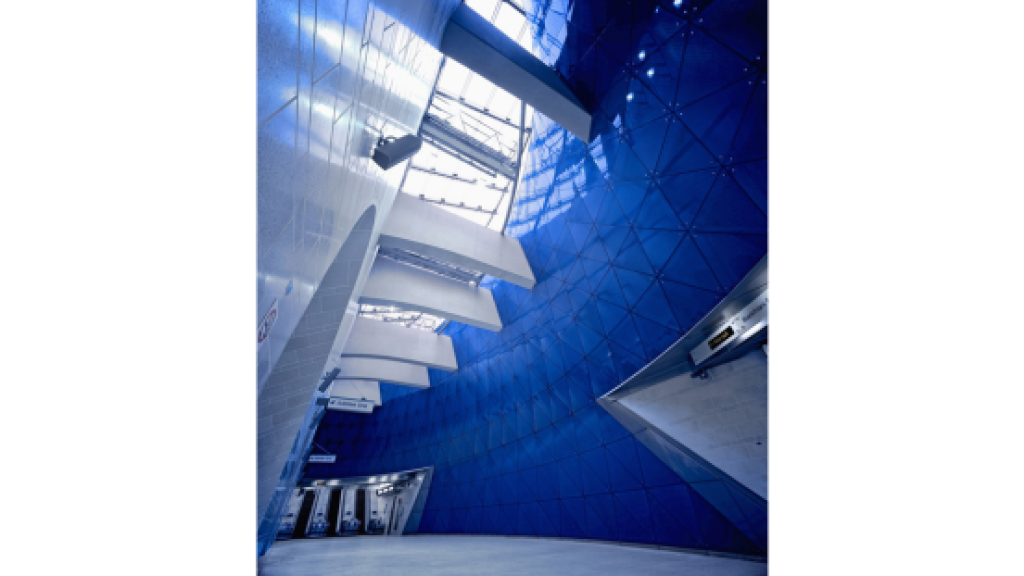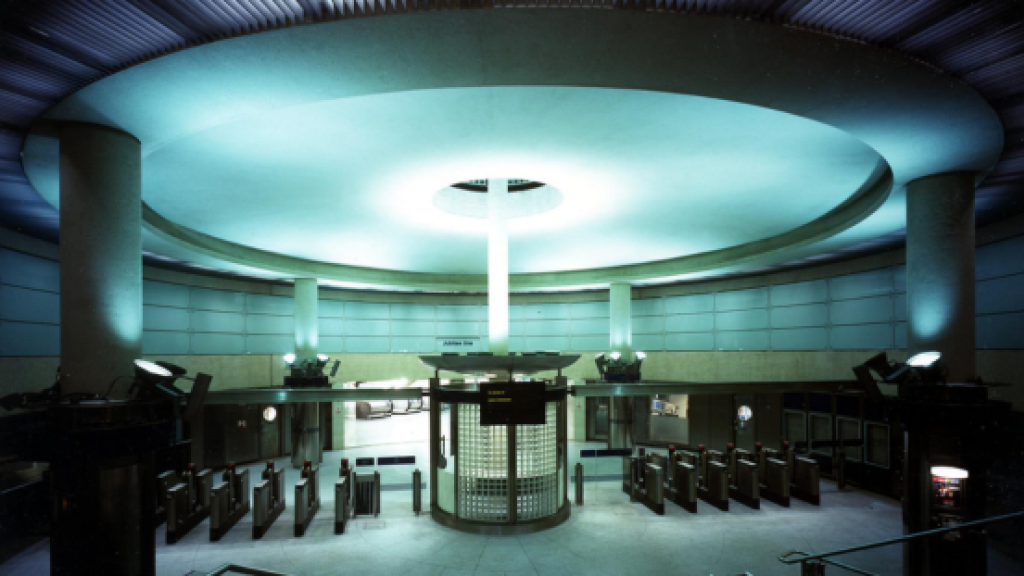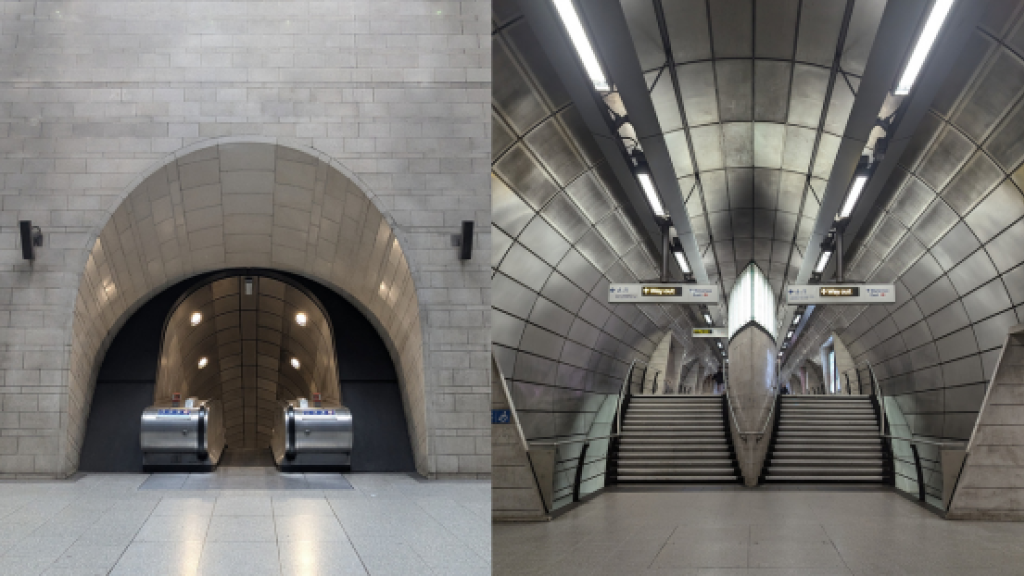SAVE backs listing for Southwark Tube station and urges ministers to assess all modern Jubilee Line stations
Remarkable set of stations needs celebration and recognition – as spectre of redevelopment looms
26th September 2024
SAVE is calling on Culture Secretary Lisa Nandy to list the 11 stations on the modern Jubilee Line extension which all opened in 1999. It comes as Historic England opens a new listing assessment of Southwark Tube station which is currently underway.
SAVE previously called for the assessment of all the Jubilee Line extension stations in 2017. We urge the government – which ultimately takes decisions on listings – to take this opportunity to carry out a survey of all the modern Jubilee Line extension stations, each of which was designed by a different architect.
In our letter to the Secretary of State we say: “We consider these award-winning buildings, all commissioned by Roland Paoletti and opened in the same year in 1999, should be assessed as a group for their architectural and historical significance... SAVE considers the modern stations on this line to be award-winning public architecture at its best, designed by some of the greatest architects of a generation.”
Henrietta Billings, director of SAVE Britain’s Heritage, said: “The Jubilee Line extension is one of the most important and thrilling examples of public transport infrastructure and architecture in Britain. Roland Paoletti commissioned up-and-coming designers as well as established practices, with outstanding unique and creative results for each station that have stood the test of time. Southwark, along with all the extension stations, needs celebration and recognition now and for future generations. We welcome this new listing assessment and urge the Secretary of State to go further and list all 11 stations.”
Jubilee Line extension stations
The Jubilee Line extension stations were commissioned by Roland Paoletti, soon after he completed the impressive new Metro in Hong Kong. He chose a group of talented architects both established and at the beginning of their careers – including Sir Norman Foster (Canary Wharf), Will Alsop (North Greenwich), Sir Richard MacCormac (Southwark), Ian Ritchie (Bermondsey), Chris Wilkinson (Stratford), and Michael Hopkins (Westminster). Under Paoletti’s guidance, each station was unique, designed by different architectural practices, and yet united by a common design philosophy in which the architectural practices worked in collaboration with an engineering firm.
Southwark Tube station
Built between 1994-1999, Southwark Station is an outstanding example of award-winning public architecture, designed by MacCormac Jamieson Prichard architects (partner in charge Richard MacCormac), as part of an ambitious project to extend the Jubilee Line from Westminster to Stratford. With its rotunda entrance and striking blue glass wall, it won awards from the Royal Institute of British Architects and The Royal Fine Arts Commission in 2000.
As described in the Times (1999) by Marcus Binney, founder and president of SAVE, MacCormac’s logically planned station design unfolds “like an opera in three acts. The entrance to the sunken rotunda ticket hall is like a descent into a whirlpool, with four flights of concentric steps narrowing into two”. The station as a whole exemplifies construction of the highest quality, with “subtly coloured and highly-polished" concrete finishes and an operatic glass screen designed by artist Alexander Beleschenko inspired by Karl Friedrich Schinkel's set design for The Magic Flute. The curved wall consists of 630 triangular panes of blue glass, secured by stainless-steel spiders to withstand the wind forces generated by the trains in the tunnels.
Alexander Beleschenko and the author of The Jubilee Line Extensions, Ken Powell, are both supporting the new listing bid for Southwark.
Previous listing bid and SAVE event
In 2017, a listing application for Southwark Station, put forward by the Twentieth Century Society, was triggered by reports that TfL planned to demolish the concourse of Southwark Tube station as part of a major redevelopment of the site. Historic England, the government’s advisor on heritage, ultimately turned the station down for listing.
In response to the decision not to list, SAVE coordinated a letter published in the Times (31 July 2017) signed by leading architects and architectural historians including several of the architects involved in the JLE project, calling on the Secretary of State to assess all the modern Jubilee Line extension stations for their architectural and historical significance.
The same year, SAVE convened a special panel discussion to highlight the architectural significance and vulnerability of all the station buildings. Original architects of the station buildings including Ian Ritchie, Michael and Patty Hopkins and Will Alsop took part in the event which was chaired by architecture critic and journalist Jonathan Glancey.
In 2021, new plans for a 17-storey office block above Southwark Tube station were approved by Southwark council’s planning committee, but did not affect the station’s interiors. With works yet to commence, a recent report from July 2024 to TfL’s Land and Property Committee revealed that the developer Helical has recommended this office scheme be redesigned as purpose-built student accommodation and affordable housing. It is currently unknown what impact this scheme would have on the station building if permitted.
A new recommendation from Historic England and a decision from the Secretary of State on listing for Southwark is expected over the next few months.
ENDS
Notes to editors:
1/ For more information contact elizabeth.hopkirk@savebritainsheritage.org or call the office on 020 7253 3500.
2/ Read SAVE’s previous press release on this campaign here
3/ SAVE Britain’s Heritage is an independent voice in conservation that fights for threatened historic buildings and sustainable reuses. We stand apart from other organisations by bringing together architects, engineers, planners and investors to offer viable alternative proposals. Where necessary, and with expert advice, we take legal action to prevent major and needless losses.



